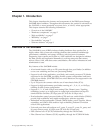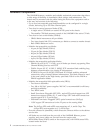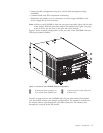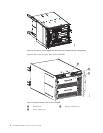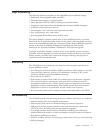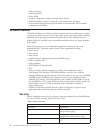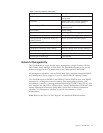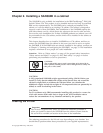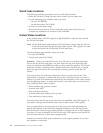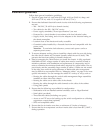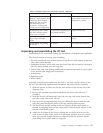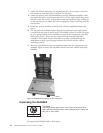
Table 3. Security features (continued)
Security features Description
FC-SP Trusted Switch (FCS) for central security
management
Secure RPC Management access controls (SNMPv3,
Telnet, FTP, serial port, front panel)
Secure file copy (SCP) Hardware-enforced zoning by WWN and/or
domain/port ID
Telnet disable Default zoning
Telnet timeout RSCN suppression and aggregation
IP filters (block listeners) Configurable RSCN suppression by port
Secure passwords (centralized control via
RADIUS/CHAP)
NTPv3 (to synchronize timestamps)
Up to 255 multiple user accounts (MUAs). Event auditing
Role-based access controls (RBACs) Change tracking
Administrative domains/Virtual fabrics Firmware change alerts in Fabric Manager
Boot PROM password reset Persistent port disable
Password hardening policies Persistent domain ID
Upfront login in Web Tools E_port disable
Network Manageability
The SAN384B has a single domain and is managed as a single element with the
Data Center Fabric Manager or Web Tools. The SAN384B responds to its own IP
address and appears as a separate entity to the Telnet protocol and SNMP.
All management interfaces, such as Telnet, Web Tools, standards compliant SMI-S,
and Management Server, support a "port N within blade M" naming scheme.
The SAN384B supports SNMPv1 and SNPMv3. When SNMP devices send SNMP
messages to a management console running SAN management software, the
information is stored in a management information base (MIB). Fabric OS v6.2 and
later supports the latest Fibre Alliance Fibre Channel Management (FCMGMT) and
Storage Management Initiative (SMI) MIBs, which allow common information
necessary for management software to provide information to a SAN
administrator.
Note: Refer to the Fabric OS MIB Reference for additional MIB information.
Chapter 1. Introduction 9



